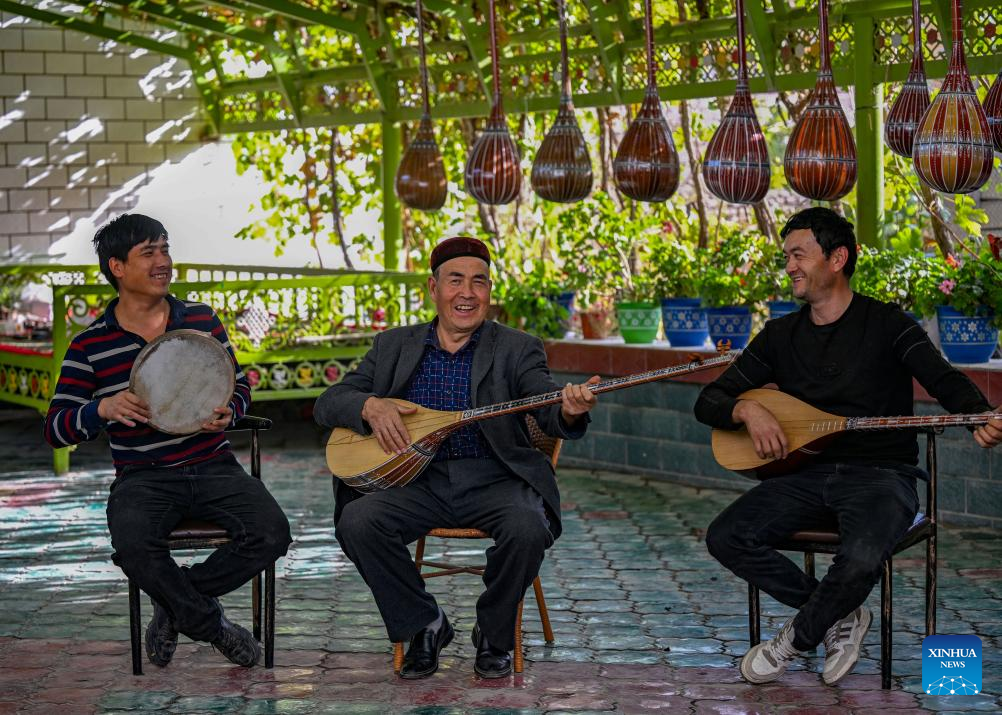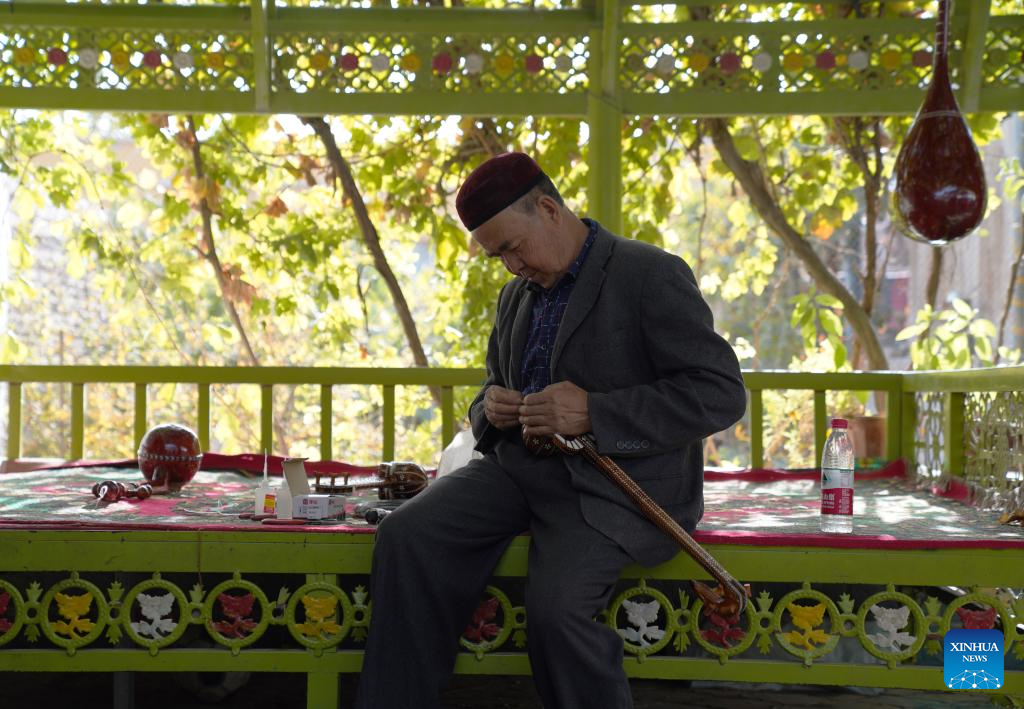Ethnic instrument making plays high notes in Xinjiang village

Nurdun Esmayil installs strings for a folk musical instrument with his friend at home in Xinhe County, northwest China's Xinjiang Uygur Autonomous Region, Oct. 29, 2024. (Xinhua/Hu Huhu)
URUMQI, Nov. 13 (Xinhua) -- In a small courtyard dappled with light under a grape arbor, 65-year-old Nurdun Esmayil was making handmade folk musical instruments with his family and apprentices. Although he cannot read music, his keen ears have enabled him to make and play these instruments with precision.
Hailing from a village in Xinhe County, northwest China's Xinjiang Uygur Autonomous Region, Nurdun Esmayil is a master craftsman specializing in making Uygur folk musical string instruments like dutar, tambur, and satar.
An important town along the ancient Silk Road up to 2,000 years ago, the county is known for the traditional Kucha music and dance, named after the ancient kingdom of Kucha.
While China has attached importance to preserving ethnic culture, recognizing traditional craftsmanship skills as intangible cultural heritage and encouraging businesses to help pass down such skills, locals have developed the ethnic instrument manufacturing industry as a key source of income.
Born into a family making instruments, Nurdun Esmayil has been in the business for over 40 years.
In 2008, Xinhe County's ethnic instrument-making techniques were added to China's national intangible cultural heritage list. That same year, he was officially recognized as a regional-level inheritor of this tradition, receiving financial support to continue his work.
He has trained over 100 apprentices, passing down his knowledge to ensure the art does not fade away. His method is rigorous.
"Crafting a tuning peg can be mastered in a week, but to meet my standards, they should spend at least a year," he said, underscoring the level of precision just like what his father taught him when he was young.
The materials Nurdun Esmayil uses have changed over the years, ranging from traditional mulberry wood to other imported international kinds. Traditional sheep-gut strings have given way to modern nylon.
"Unlike in the past, when it was extremely hard to deliver an ideal piece of wood home because of the bumper road and no vehicles, now we can have any materials delivered from anywhere in the world," he said.
Nowadays, the village is home to more than 120 instrument artisans producing over 50 varieties of instruments, with more than 20,000 pieces sold every year.
Eyeing the potential of the village's unique intangible cultural heritage, local authorities have rebranded the area as a tourist destination under the "musical instrument village" brand, drawing visitors from around China and abroad.
Inspired by peers, Nurdun Esmayil is considering registering a trademark to pass down the cultural heritage better and leave it as a legacy to his family.
Born in the internet era, his 12-year-old grandson likes playing drums and dancing to welcome visitors, showing promise as a potential inheritor of the family's musical legacy.
"If I could start over, I'd study music theory, read music and play all kinds of music that I want to," Nurdun Esmayil said, watching his grandson attentively.

Nurdun Esmayil (C) plays music with his son, Ehmet Nurdun (L), and his apprentice in his courtyard in Xinhe County, northwest China's Xinjiang Uygur Autonomous Region, Oct. 15, 2024. (Xinhua/Chen Shuo)

Nurdun Esmayil makes rewap, a folk musical instrument, in his courtyard in Xinhe County, northwest China's Xinjiang Uygur Autonomous Region, Oct. 15, 2024. (Xinhua/Liu Mengqi)
Photos
Related Stories
- Golden desert poplar trees adorn Xinjiang's landscape
- Inaugural Central Asian Indoor Athletics Invitational opens in Xinjiang
- Bonded aircraft repair takes off in China's Xinjiang
- Xinjiang launches freight train route to Central Asia
- Elderly couple leads an effort to plant over 40,000 trees in desert in NW China's Xinjiang
Copyright © 2024 People's Daily Online. All Rights Reserved.









